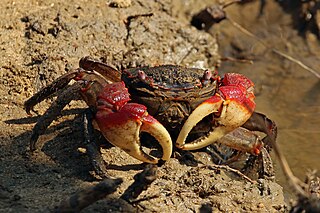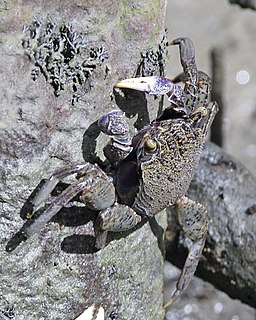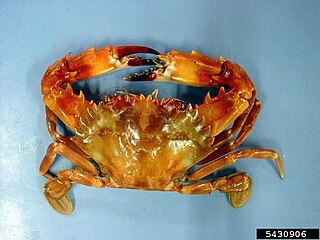
Crabs are decapod crustaceans of the infraorder Brachyura, which typically have a very short projecting "tail" (abdomen), usually hidden entirely under the thorax. They live in all the world's oceans, in fresh water, and on land, are generally covered with a thick exoskeleton, and have a single pair of pincers. Many other animals with similar names – such as hermit crabs, king crabs, porcelain crabs, horseshoe crabs, and crab lice – are not true crabs, but many have evolved features similar to true crabs in a process of carcinisation.

Mangrove crabs are crabs that live among mangroves, and may belong to many different species and even families. They have been shown to be ecologically significant in many ways. They keep much of the energy within the forest by burying and consuming leaf litter. Along with burrowing in the ground, at high tide and in the face of predators these crustaceans can climb trees to protect themselves. The hermit crab and the mangrove crab are the only crustaceans that can climb trees as a defense mechanism. Furthermore, their feces may form the basis of a coprophagous food chain contributing to mangrove secondary production.

The velvet crab, or alternately velvet swimming crab, devil crab, “fighter crab”, or lady crab,Necora puber, is a species of crab. It is the largest of the swimming crab family (Portunidae) found in British coastal waters. It has a carapace width of up to 100 millimetres (3.9 in), and is the only species in the genus Necora. Its body is coated with short hairs, giving the animal a velvety texture, hence the common name. It is one of the major crab species for United Kingdom fisheries, in spite of its relatively small size.

Portunus armatus, also known as the flower crab, blue crab, blue swimmer crab, blue manna crab or sand crab, rajungan in Indonesian, and alimasag in Tagalog, Kapampangan, and Pangasinan, is a large crab found in the intertidal estuaries around most of Australia and east to New Caledonia.

Charybdis is a genus of swimming crabs in the family Portunidae; "Charybdis" is Greek for whirlpool.

Thalassina is a genus of mud lobsters found in the mangrove swamps of the Indian Ocean and western Pacific Ocean. Its nocturnal burrowing is important for the recycling of nutrients in the mangrove ecosystem, although it is sometimes considered a pest of fish and prawn farms.
Parasesarma erythrodactyla, also known as the red-handed shore crab, is a burrowing crab inhabiting mangrove forests in Australia and Southeast Asia. It is immediately identifiable by its bright red chelipeds (claws) and green/brown carapace.

Callinectes similis, sometimes called the lesser blue crab or dwarf crab, is a West Atlantic species of blue crab. It was described by Austin B. Williams in 1966.

Liocarcinus holsatus, sometimes known by the common name flying crab, is a species of swimming crab found chiefly in the North Sea, Irish Sea and English Channel. It has a carapace up to 4 centimetres (1.6 in) wide, which is brownish-grey with a green tinge. It is very similar in appearance to the harbour crab Liocarcinus depurator.

Cerithidea decollata, common name the truncated mangrove snail, is a species of sea snail, a marine gastropod mollusc in the family Potamididae.

Inachus phalangium, Leach's spider crab, is a species of crabs from the north-eastern Atlantic Ocean and Mediterranean Sea. It is up to 20.5 mm (0.81 in) wide, and is very similar to other species in the genus Inachus.

Neolithodes is a genus of king crabs, in the family Lithodidae. They are found in all major oceans, both in high and low latitudes. Although there are records from water as shallow as 124 m (407 ft) in cold regions, most records are much deeper, typically 700–2,000 m (2,300–6,600 ft), with the deepest confirmed at 5,238 m (17,185 ft). They are fairly large to large crabs that typically are reddish in color and spiny, although the size of these spines varies depending on species.

Lissocarcinus orbicularis, common names sea cucumber crab and red-spotted white crab, is a species of crabs in the family Portunidae.

Shrimp are decapod crustaceans with elongated bodies and a primarily swimming mode of locomotion – most commonly Caridea and Dendrobranchiata. More narrow definitions may be restricted to Caridea, to smaller species of either group or to only the marine species. Under a broader definition, shrimp may be synonymous with prawn, covering stalk-eyed swimming crustaceans with long narrow muscular tails (abdomens), long whiskers (antennae), and slender legs. Any small crustacean which resembles a shrimp tends to be called one. They swim forward by paddling with swimmerets on the underside of their abdomens, although their escape response is typically repeated flicks with the tail driving them backwards very quickly. Crabs and lobsters have strong walking legs, whereas shrimp have thin, fragile legs which they use primarily for perching.

Francesca Gherardi was an Italian zoologist, ethologist, and ecologist. Most of her work was performed at the Department of Biology of the University of Florence, Italy, where she was a researcher and an associate professor.

The violet vinegar crab is a swimming crab species in the genus Episesarma. Distributed all over marine and brackish waters of Indo-West Pacific regions. It is harvested by many local fishermen for rich proteinaceous food.
Neosarmatium smithi, is a swimming crab species in the genus Neosarmatium. Distributed all over marine and brackish waters of Indo-West Pacific regions.

Charybdis hellerii, the Indo-Pacific swimming crab or spiny hands is a species of crab from the swimming crab family, the Portunidae. Its native range covers the Indian and Pacific Oceans but it has been introduced to the western Atlantic and has invaded the Mediterranean. It is a commercially exploited species in south-east Asia.
Charybdis longicollis, the lesser swimming crab, is a species of crab from the swimming crab family, the Portunidae. It has a native range which covers the north-western Indian Ocean and it has been invaded the Mediterranean Sea by Lessepsian migration through the Suez Canal.
The horsehair crab, Erimacrus isenbeckii, is a species of crab which is found mainly in the Northwest Pacific, around the Hokkaido coast in the Sea of Okhotsk and the Western Bering Sea and is an important commercial species used in Japanese cuisine. Despite the importance of the species, biological studies are usually specialized and limited. The catch for the species reached a peak in the 1950s at 27,000 tons and has decreased since, reaching 2,000 tons in 2003. Due to the commercial importance of the species, many stock enhancement programs have been utilized to help maintain a successful fishery. The species is commonly found on sandy benthic environments from shallow water to depths of up to 350 meters.
















